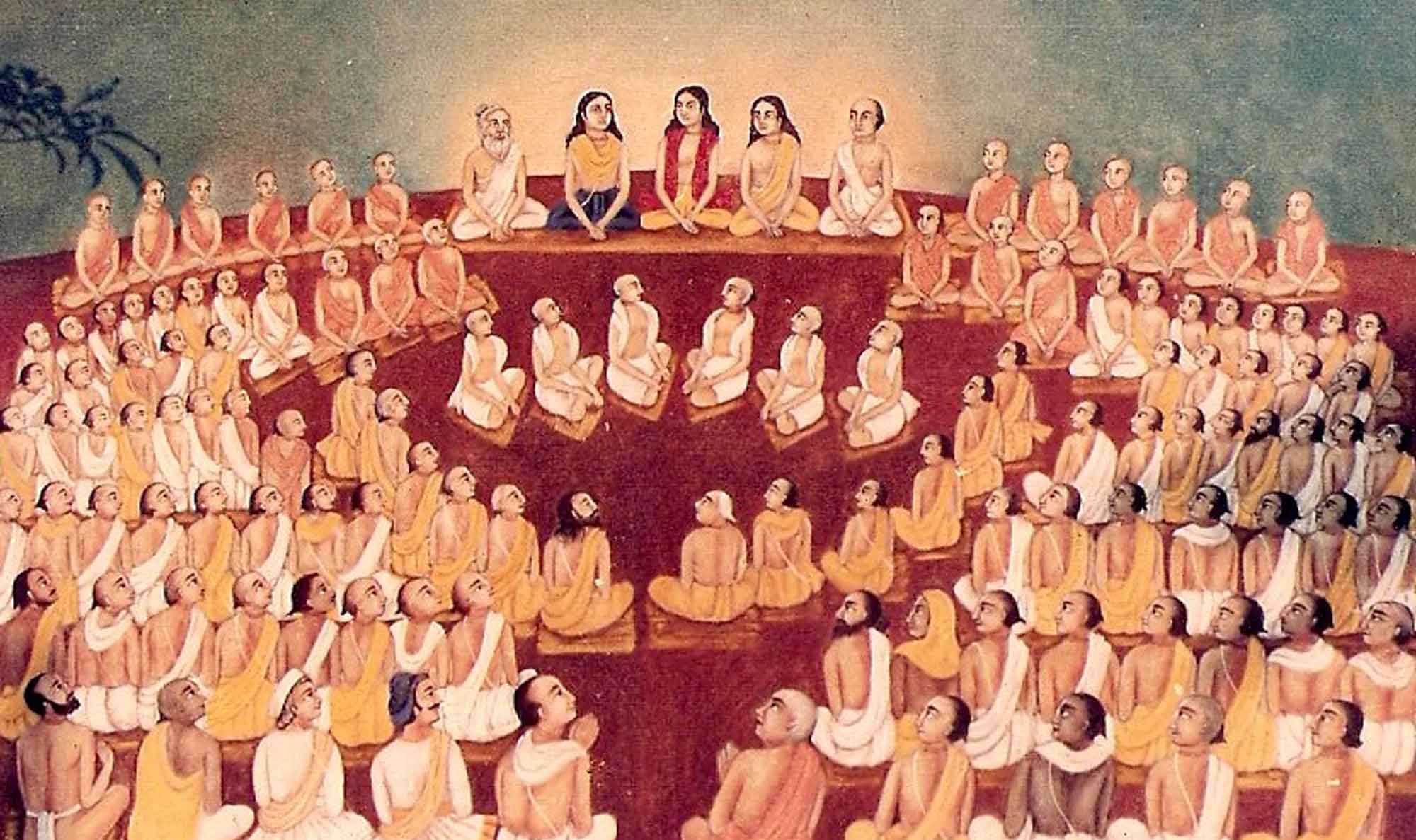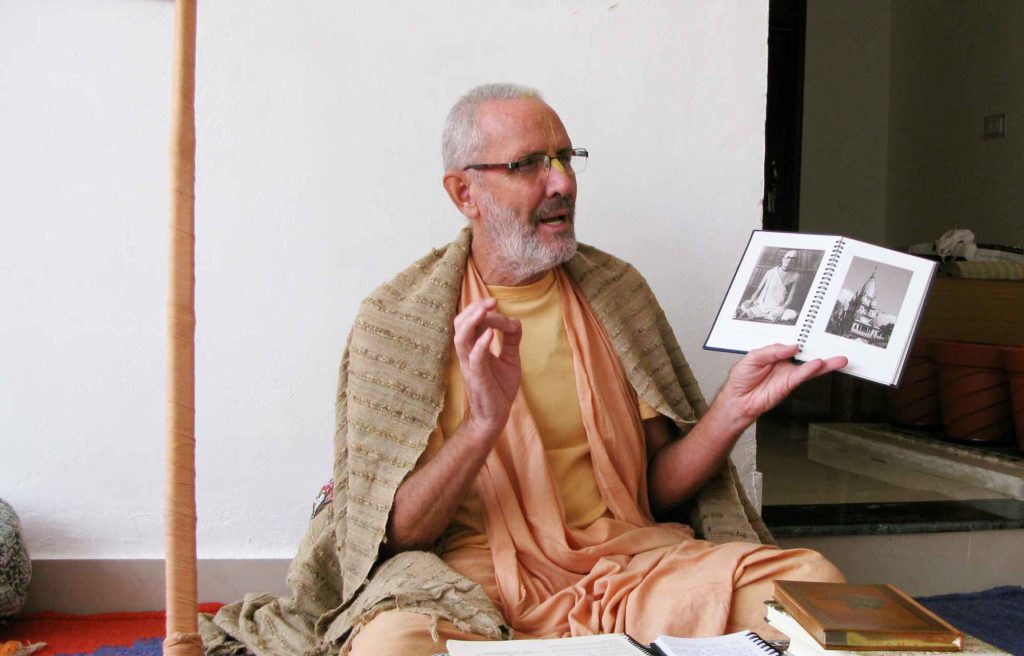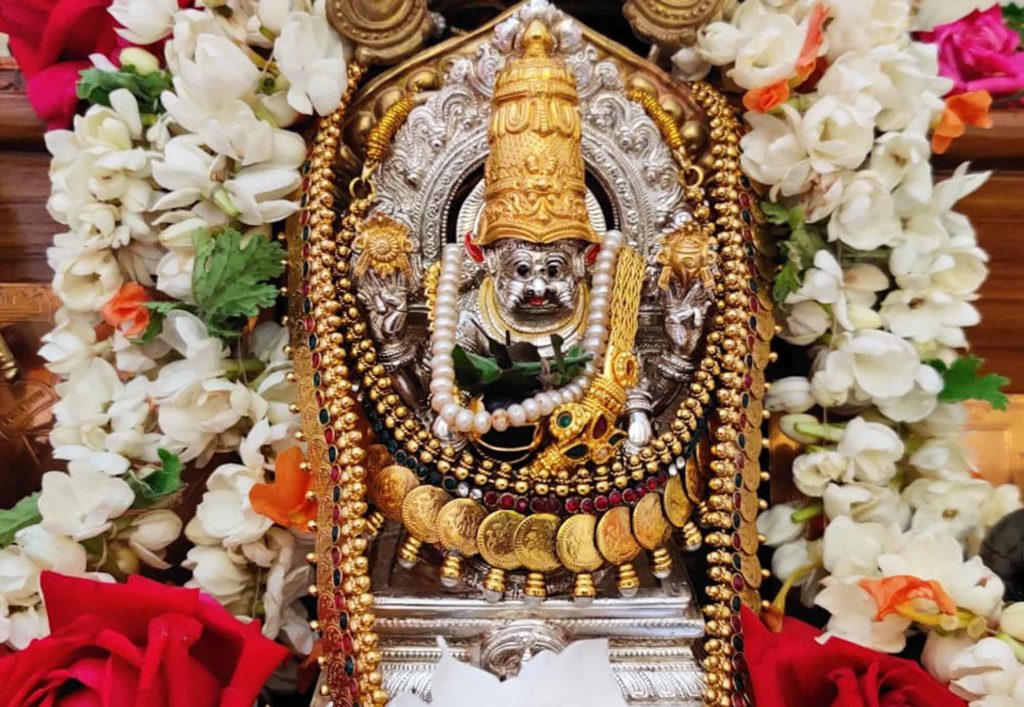Overview
‘Paramparā’ was written by Swami Narasingha in March 2004. In this essay, Narasingha Maharaja answers a question about the ‘gaps’ within the Gauḍīya paramparā as give by Sarasvatī Ṭhākura.
Question: I have heard it said that there are some gaps in the list of names in the Gaudīyā paramparā and that some of the names given there are actually fictitious names of personalities that never really existed. Do you think this could be true?
Answer: In Gaura-ganoddesa-dīpikā Śrīla Kavi Karṇapūra lists the paramparā of the Gaudīyā Vaiṣṇavas from Lord Brahmā up to Śrī Caitanya Mahāprabhu as follows:
tatra mādhvī sampradāyaḥ prastavād atra likhyate—
paravyomeśvarasyāsīc chiṣyo brahmā jagat-patiḥ
tasya śiṣyo nārado’bhūd vyāsas tasyāpa śiṣyatām
śuko vyāsasya śiṣyatvaṁ prāpto jñānāvarodhatāt
tasya śiṣyāḥ praśiṣyāś ca bahavo bhūtale sthitāḥ
vyāsāl labdha-kṛṣṇa-dīkṣo madhvācāryo mahā-yaśaḥ
cakre vedān vibhajyāsau saṁhitāṁ śata-dūṣaṇīṁ
nirguṇād brahmaṇo yatra sa-guṇasya pariṣkriyā
tasya śiṣyo’bhavat padmanābhācāryo mahāśayaḥ
tasya śiṣyo naraharis tac-chiṣyo mādhava-dvijaḥ
akṣobhyas tasya śiṣyo’bhūt tac-chiṣyo jayatīrthakaḥ
tasya śiṣyo jñānasindhus tasya śiṣyo mahānidhiḥ
vidyānidhis tasya śiṣyo rājendras tasya sevakaḥ
jayadharma-munis tasya śiṣyo yad-gaṇa-madhyataḥ
śrīmad-viṣṇupurī yas tu bhakti-ratnāvalī-kṛtiḥ
jayadharmasya śiṣyo’bhūd brāhmaṇaḥ puruṣottamaḥ
vyāsa-tīrthas tasya śiṣyo yaś cakre viṣṇu-saṁhitām
śrīmān lakṣmīpatis tasya śiṣyo bhakti-rasāśrayaḥ
tasya śiṣyo mādhavendro yaddharmo’yaṁ pravartitaḥ
kalpa-vṛkṣasyāvatāro vraja-dhāmani tiṣṭhitaḥ
prīta-preyo vatsalatojjvalākhya phala-dhāriṇaḥ
tasya śiṣyo’bhavac chrīmān īśvarākhya-purī-yatiḥ
kalayāmāsa śṛṅgāraṁ yaḥ śṛṅgāra-phalātmakaḥ
advaitaḥ kalayāmāsa dāsya-sākhye phale ubhe
śrīmān raṅgapurī hy eṣa vātsalye yaḥ samāśritaḥ
īśvarākhya-purīṁ gaura urarīkṛtya gaurave
jagad āplāvayāmāsa prākṛtāprākṛtātmakam
“I shall now begin this book by describing the disciplic succession descended from Śrīpāda Madhvācārya. Lord Brahmā, the creator of the universe became the disciple of the Supreme Personality of Godhead, Lord Narayana. Brahmā’s disciple was Nārada. Nārada’s disciple was Vyāsa. Vyāsa then transmitted transcendental knowledge to his disciple Śukadeva. Śukadeva taught the same knowledge to his many disciples and grand-disciples in this world. The famous Madhvācārya received initiation from Vyāsa personally. Madhvācārya carefully studied all the Vedas from Vyāsa, and later wrote his book Māyāvāda-śata-duśaṇī, where he proved that the Absolute Truth is the Supreme Person, full of all transcendental qualities, and not the quality-less impersonal Brahmān. Madhvācārya’s disciple was the exalted Padmanābhācārya. Padmanābhācārya’s disciple was Narahari. Narahari’s disciple was Mādhava-dvīja. Mādhava-dvīja’s disciple was Akṣobhya. Akṣobhya’s disciple was Jaya Tīrtha. Jaya Tīrtha’s disciple was Jñānasindhu. Jñānasindhu’s disciple was Mahānidhi. Mahānidhi’s disciple was Vidyānidhi. Vidyānidhi’s disciple was Rājendra. Rājendra’s disciple was Jayadharma Muni. Among Jayadharma Muni’s disciples was Śrīman Viṣṇupurī, the famous author of the Bhakti-ratnāvali. Another disciple of Jayadharma was Brāhmāna Puruṣottama. Purusottama’s disciple was Vyāsa Tīrtha, who wrote the famous book Śrī Viṣṇu-saṁhitā. Vyāsa Tīrtha’s disciple was Śrīman Lakṣmīpati, who was like a great reservoir of the nectar of devotional service. Lakāmīpati’s disciple was Mādhavendra Purī, a great preacher of devotional service. Mādhavendra Purī was the incarnation of a kalpa-vṛkṣa tree in the abode of Vraja. This tree bears as its fruits the mellows of servitude to Lord Kṛṣṇa, friendship with Lord Kṛṣṇa, parental love for Lord Kṛṣṇa, and conjugal love for Lord Kṛṣṇa. Mādhavendra Purī’s disciple was Śrīman Īśvara Purī Svāmī. Īśvara Purī carefully understood the mellows of conjugal love for Lord Kṛṣṇa, and was able to distribute that fruit to others. Śrī Advaita Ācārya displayed the sentiments of servitorship and friendship for the Lord, and Śrīman Raṅga Purī manifested the sentiment of parental love for Lord Kṛṣṇa. Lord Caitanya accepted Śrīman Īśvara Purī as His spiritual master. The Lord proceeded to flood the entire world with spontaneous transcendental love for Kṛṣṇa.” (Gaura Gaṇoddeśa-dīpikā 22-25)
The above-mentioned disciplic succession given by Kavi Karṇapūra has been accepted by Bhaktivinoda Ṭhākura and this is evident from the following statement:
ei samasta vakyadvārā spaṣta pratita haya ye, śrī brahma sampradāyai śrī kṛṣṇa caitanya-dāsadigaṇera guru-praṇālī. śrī kavi karṇapūra gosvāmī ei anusare dṛta kariyā sviya kṛta gaura-gaṇoddeśa-dīpikā’ yā guru-praṇālīra-krama likhiyāchen. vedānta-sūtra-bhāṣyakāra śrī vidyābhūṣaṇa u sei praṇālīke sthīra rakhiyācchen. yāhāra ei praṇālīke asvikāra karen, tāhāra ye śrī kṛṣṇa caitanya-caraṇānucāra-gaṇera pradhāna śatru, ihate āra sandeha ki?
“It is evident that Śrī Caitanya Mahāprabhu belonged to the Brahmā sampradāya, as it descends through Madhvācārya. Kavi Karṇapūra confirmed this line of disciplic succession in his Gaura Gaṇoddeśa-dīpikā, and the writer of the commentary of the Vedānta, Śrī Baldeva Vidyābhūṣaṇa, did so again (in his Prameya Ratnāvali). Is there any doubt that those who do not accept this line of disciplic succession are the principle enemies of the followers of Śrī Kṛṣṇa Caitanya?” (Bhaktivinoda Ṭhākura – Śrī Mahāprabhur-śikṣā, Ch.2)
Bhaktivinoda further states in Chapter Two of Śrī Mahāprabhur-śikṣā that anyone who does not accept these statements is an atheist:
śrī kṛṣṇa caitanya sampradāya svikāra karata gopane guru-paramparā siddha-praṇālī svikāra karen nā, tāhāra kalir guptācāra. ihate sandeha ki?
“Anyone who refuses to accept such statements is a promoter of atheism. Those who accept the authority of Śrī Kṛṣṇa Caitanya but secretly do not accept this disciplic succession of spiritual preceptors are actually agents of Kali. Can there be any doubt about this?” (Bhaktivinoda Ṭhākura – Śrī Mahāprabhur-śikṣā, Ch.2)
Considering the position of Śrīla Kavi Karṇapūra, it is highly unlikely he would have simply fabricated a list of names to make up the paramparā of Śrī Caitanya. Kavi Karṇapūra was the son of Śivānanda Sena and he was thus always associated with pure devotees and with the eternal associates of the Supreme Lord. The information that Kavi Karṇapūra gives us about the identities of Mahāprabhu’s associates in gaura-līlā and their corresponding identities in kṛṣṇa-līlā is extensive. It is therefore quite unlikely that having access to such confidential information as regards the eternal associates of the Lord that he would at the same time fabricate a fictitious paramparā.
As Kavi Karṇapūra has heard from senior devotees about the identities of Mahāprabhu’s associates, he similarly heard from them regarding the paramparā. In fact, although it may not be mentioned in any particular book, it is widely accepted that Śrī Caitanya heard about the paramparā of Mādhavendra Purī at the time of his initiation from Īśvara Purī, the disciple of Mādhavendra.
If what Kavi Karṇapūra had written in Gaura-ganoddesa-dīpikā regarding the Gaudīyā sampradāya paramparā was indeed false – then the senior Vaiṣṇavas present on the planet at that time would indeed have objected to those statements. Yet such objections were never raised. On the contrary, the community of Vaiṣṇavas and pure devotees of Śrī Caitanya accepted the writings of Kavi Karṇapūra as bona-fide transcendental literature.
Just as we have heard from our spiritual master about the lineage of our paramparā, so it has always been the tradition among Vaiṣṇavas that a spiritual master informs and enlightens his disciple regarding their paramparā.
The fact that there are also sometimes gaps in the paramparā list of names, does not mean that there is an actual break in the paramparā. This topic has been briefly explained by Bhaktivinoda in Jaiva-dharma as follows:
sampradāya-praṇālī ki sampūrṇa-rūpa rakhā haiyacche? madhye madhye ye sakala pradhāna ācārya haiyacchen, tāhāder nāma sakala sampradāya praṇālīte ācche.
“Is there a list of names of spiritual masters in the paramparā given without any breaks?
From time to time, only the more important spiritual masters’ names are included in these lists.” (Jaiva-dharma – Ch.13)
Although envious persons or persons with a poor fund of knowledge are sometimes quick to criticize the Gaudīyā sampradāya for such apparent breaks in their paramparā, the fact is that there are also apparent breaks in other recognized and established sampradāyas such as the Madhva sampradāya and the Rāmānuja sampradāya.
These apparent breaks are also acknowledged as existing by Madhva and Rāmānuja followers, but these apparent breaks are not considered as defects in their respective sampradāyas.
In the books Sampradāya Paddhati and Maṇi-mañjarī written by Hṛṣīkeśa Tīrtha and Nārāyaṇa Paṇḍitācārya respectively (both direct disciples of Madhvācārya) the paramparā of the Madhva sampradāya is given as follows:
Haṁsāvatāra, Brahmā, Catuḥsana, Dūrvāsa, Jñānasindhu Tīrtha, Garuḍavāhana Tīrtha, Kaivalya Tīrtha, Jñānīśa Tīrtha, Parā Tīrtha, Satya-prajña Tīrtha, Prajña Tīrtha, Acyuta Prekṣa, and Madhvācārya.
The gap between Acyuta Prekṣa (the guru of Madhva) and Prajña Tīrtha (the previous ācārya) is approximately 400 years. The reason for this gap is explained that, during this time the Vaiṣṇavas in that area were being terrorised by the Nāgā Bābās, and other militant followers of Śaṅkarācārya. They had gone completely ‘underground’ as a result of it. After the time of Madhvācārya the social climate changed and the Vaiṣṇavas were able to resume their normal behaviour and lived openly in society, establishing maṭhas, keeping paramparā records, etc.
A similar gap, but this time of approximately 3,000 years, is found in the Rāmānuja sampradāya. The recognized paramparā of the Rāmānuja sampradāya from Viṣṇu up to Rāmānuja is as follows:
Viṣṇu, Lakṣmī, Viśvāksena, Āḷvars, Nāthamuni, Puṇḍarīkākṣa, Rāma Miśra, Yāmunācārya, and Rāmānujācārya.
From the Āḷvars (4000 BC to 2700 BC) to Nāthamuni (584AD) there is a gap of more than 3,000 years. Despite this apparent gap the Rāmānuja paramparā is accepted by all Vaiṣṇava scholars as a bona fide sampradāya. Also, it has been noted that during the period of the Āḷvars, only Nammāḷvar and Madhurakavi were connected as guru and disciple respectively. All the other ten Āḷvars were independent of each other. In other words, they were not related in any way as guru and disciple.
The point of contention wherein some persons try to establish that one must be in a disciplic succession that can produce a list of names of its paramparā (guru to disciple) from the present day back to its very origin and prove the validity of those names by producing old texts where such names are mentioned is not actually necessary, nor is such a method accepted by other sampradāyas as the ultimate pramāṇa (proof). If it were so, then it would not be possible to factually prove an unbroken chain of disciplic succession in any sampradāya in the world today. Even those so-called sampradāyas of bābājīs in Vṛndāvana and Māyāpura who claim to have an unbroken disciplic succession, can only prove such by creating imaginary literature and fabricating lies in support of their fallacious claims.
Actually the evidence supporting the validity of any sampradāya via old books, historical records and all such related materials are for the most part empirical evidence and this is considered secondary to the most important type of evidence known as śrota-panthā or having heard from previous ācāryas.
The mind and intelligence being material elements of this mundane world are prone to rational thought and want proof of everything by the process of empirical knowledge. Ultimately empirical knowledge is defective because it is gathered by the imperfect senses. The process of śrota-panthā however is the process by which realized knowledge of the Absolute Truth is passed down from guru to disciple without any loss. This process depends not on empirical evidence to prove its validity, but the process of śrota-panthā depends solely on hearing with faith.
The empirical philosopher cannot accept the reality of faith because he or she has no experience of faith. Such less spiritually advanced persons do not know that faith (śraddhā) is a spiritual substance more real than all the empirical knowledge of the mundane world combined.
Faith allows the descending eternal knowledge (śabda-brahman) to flow through the realized spiritual master to the heart of a qualified disciple completely unobstructed by any material defect. The knowledge of the empiricist however is always wrought with troubles and defects because it is an ascending process and depends solely on the material mind, intelligence, and senses, which are imperfect.
Those faithful devotees who have accepted the authority of the paramparā mentioned by Kavi Karṇapūra in Gaura-ganoddesa-dīpikā are factually the persons responsible for fulfilling the prediction of Śrī Caitanya of spreading Kṛṣṇa consciousness all over the world. This is indeed another valid proof (pramāṇa) of the validity of their paramparā, for as Kṛṣṇa Dāsa Kavirāja Gosvāmī states in Caitanya-caritāmṛta – only those who are empowered by Kṛṣṇa can spread the holy name of Kṛṣṇa:
tāhā pravartaila tumi ei ta pramāṇa
kṛṣṇa-śakti dhāra tumi ithe nāhi āna
On the other hand, those who doubt the integrity of Kavi Karṇapūra and his followers such as Śrī Baladeva Vidyābhūṣaṇa, and Śrīla Bhaktivinoda Ṭhākura are to be compared to a thorn in the leg of the Supreme Lord and the association of such unfortunate persons should be rejected.
Related Articles
- Guru is One by Śrīla Bhakti Gaurava Narasiṅgha Mahārāja
- Omniscience? by Śrīla Bhakti Gaurava Narasiṅgha Mahārāja
- Paramparā by Śrīla Bhakti Gaurava Narasiṅgha Mahārāja
- The Vision of Guru by Śrīla Bhakti Gaurava Narasiṅgha Mahārāja
- Ekalavya and Arjuna by Śrīla Bhaktisiddhānta Sarasvatī Ṭhākura
- Can the Guru Make Mistakes? by Śrīla Bhakti Gaurava Narasiṅgha Mahārāja
- The Post of Guru by Śrīla Bhakti Gaurava Narasiṅgha Mahārāja
- The Compassionate Nature of Śrī Guru by Śrīla Bhakti Kiśora Āraṇya Mahārāja
- Is a Guru Necessary? by Gaura Gopāla Dāsa
Prema Dhāma Deva Stotram with the Narasiṅgha Sevaka Commentary – Verses 61-65
In verses 61 to 65 of 'Prema Dhāma Deva Stotram', Śrīla Śrīdhara Mahārāja narrates the pastime of Śrī Caitanya at Caṭaka Parvata In Purī and explains how the scriptures produced by Brahmā and Śiva are ultimately searching for the personality of Mahāprabhu who is merciful too all jīvas, no matter what their social position.
Prabhupāda Śrīla Sarasvatī Ṭhākura’s Visit to Ayodhyā
With the forthcoming observance of Śrī Rāma Navamī, we present 'Prabhupāda Śrīla Sarasvatī Ṭhākura’s Visit to Ayodhyā' written by Śrīla Bhaktisiddhānta Sarasvatī Ṭhākura Prabhupāda from The Gaudīyā magazine, Vol 3. Issue 21/ In December 1924, after visiting Benares and Prāyāga, Sarasvatī Ṭhākura visited the birth-site of Śrī Rāmācandra in Ayodhyā.
Śaraṇāgati – The Only Path to Auspiciousness
In this article, 'Śaraṇāgati - The Only Path to Auspiciousness', Dhīra Lalitā Dāsī analyses the process of śaraṇāgati (surrender) beginning with śraddhā (faith). She also discusses the role of śāstra and the Vaiṣṇava in connection with surrender.
Ātma Samīkṣā – The Value of Introspection
In this article, "Ātma Samīkṣā – The Value of Introspection" Kalki Dāsa highlights the importance of introspection in the life of a devotee and especially in relation to the worldly environment that surrounds us. He also explains how transcendental sound influences our capacity to introspect.
Prema Dhāma Deva Stotram with the Narasiṅgha Sevaka Commentary – Verses 61-65
In verses 61 to 65 of 'Prema Dhāma Deva Stotram', Śrīla Śrīdhara Mahārāja narrates the pastime of Śrī Caitanya at Caṭaka Parvata In Purī and explains how the scriptures produced by Brahmā and Śiva are ultimately searching for the personality of Mahāprabhu who is merciful too all jīvas, no matter what their social position.
Prabhupāda Śrīla Sarasvatī Ṭhākura’s Visit to Ayodhyā
With the forthcoming observance of Śrī Rāma Navamī, we present 'Prabhupāda Śrīla Sarasvatī Ṭhākura’s Visit to Ayodhyā' written by Śrīla Bhaktisiddhānta Sarasvatī Ṭhākura Prabhupāda from The Gaudīyā magazine, Vol 3. Issue 21/ In December 1924, after visiting Benares and Prāyāga, Sarasvatī Ṭhākura visited the birth-site of Śrī Rāmācandra in Ayodhyā.
Śaraṇāgati – The Only Path to Auspiciousness
In this article, 'Śaraṇāgati - The Only Path to Auspiciousness', Dhīra Lalitā Dāsī analyses the process of śaraṇāgati (surrender) beginning with śraddhā (faith). She also discusses the role of śāstra and the Vaiṣṇava in connection with surrender.
Ātma Samīkṣā – The Value of Introspection
In this article, "Ātma Samīkṣā – The Value of Introspection" Kalki Dāsa highlights the importance of introspection in the life of a devotee and especially in relation to the worldly environment that surrounds us. He also explains how transcendental sound influences our capacity to introspect.








